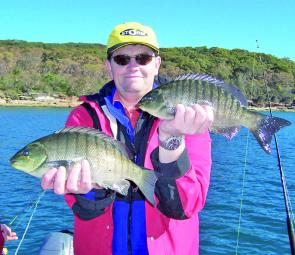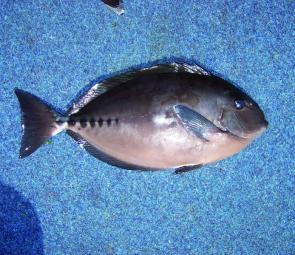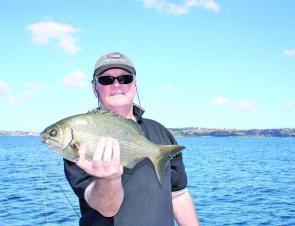Luderick are one of my favourite Winter fish, mainly because they can usually be relied on during even the worst shut-down.
This doesn’t mean that they are not available through the Summer months or that they are not worthy opponents in their own right. I use them as a standby fish because of their reliability but they require a considerable degree of skill, are hard fighting and good eating.
In Summer, when there are kingfish, salmon, bonito and tailor thrashing the surface to foam, it can be hard to divert people’s attention to luderick.
Here’s a quick rundown on techniques and I’ll finish off with my three favourite Harbour luderick spots
Genuine diehard blackfish anglers are spread pretty thin these days. The fish are still prolific, having survived the ravages of commercial fishing and pollution a lot better than most others.
Blackfish fight well, are great to eat and are found through a range of habitats that include the most tranquil estuarine reaches to harsh ocean rock environments.
They are well within reach of shore-based anglers, inexpensive to set up for and are a year-round proposition.
According to my Grandfather, they catered well to the genuine needs of families who relied on them heavily through the Depression as part of their diet. They also fulfil the less legitimate needs of the egotist through their abundance.
They require specific techniques that can take considerable time to learn but, once mastered, the fish flow freely.
The tricky bit to blackfish angling is in the control of the rig.
Light floats, long drops, wind-resistant baits and lots of sinkers add up to a rig that demands constant attention. There are two ways to go and they both have their good and bad points.
You can opt for the running float rig comprising a standard long-stemmed blackfish float free to run on the line. It's stopped a certain distance from the hook by a split shot and stopped from running all the way up the line by a stopper, which can be a piece of light string tied to the line or any one of a number of commercially produced rubber stoppers.
The main criterion for a stopper is that it clamps tightly enough to the main line to stop the float sliding any further than you want it to, but still must be loose enough that it can be moved up or down to change the depth of the drop.
The stopper must also be able to be wound through the rod guides, sometimes even onto the reel, and cast back out again without fouling.
The main advantages of this running rig is that the length of the drop from the rod tip can be as short as a couple of feet and the maximum depth of the drop below the float is infinite.
This makes it an easier rig to cast farther than the alternative but it is prone to tangling because the wind-resistant bait is very close to the float during the cast. Its common with this rig for the line and bait to tangle around the float.
The alternative rig consists of a fixed float with a split shot above and below to restrict its movement up or down the line. The float is fixed on the line at the full depth you are fishing.
The problem is that if you are fishing deep, at 3m or more, you will have that full length of line hanging from the rod tip and it’s difficult to handle.
The big advantage with this rig is that is much less prone to tangling during the cast because the bait is so far from the float. This is the rig I use most often.
Obviously if you are fishing more than about 3.5m down, this rig is not applicable, but that does not occur very often.
Weighting of the float is critical. Most floats consist of a thin stem with a streamlined float of cork or foam about two-thirds of the way up the stem.
The float must be weighted so that just the one-third of the stem above the float shows. The float is weighted with split shot, running sinkers, strip lead around the stem of the float or a combination of these.
Weather conditions dictate the size and weight of the float you use. In windy, rough conditions you need a big, heavy float and in calm conditions the smaller the float, the better. A quill float makes an ideal still-water float.
Blackfish rods are long because of the need to handle the long drop often used under the float. The extra length also helps to lift the belly out of the line when you go to strike.
Belly refers to the arc of line between the rod tip and the float often created by a cross current or wind. On a long drift, the belly can become so severe that the strike only serves to lift out the belly and sometimes never reaches the float.
The rod must be soft because the blackfish's mouth and the hooks used are small. A stiff rod would pull the hook clean out of the fish’s mouth.
The long rod offers the cushion needed to prevent this happening during the blackfish’s strong lunges.
The choice of reel is up to you. I’ve seen egg-beaters, baitcasters and centrepins used successfully. Centrepins are still used on a traditional basis rather than on their practicality.
If you opt for a centrepin then go for a sidecast style such as those made by Alvey.
I use egg-beaters because they offer open-face casting, a fast retrieve important when picking up line belly before striking, and the ability to feed line smoothly to the float to allow it to drift.
For the smaller river blackfish 6lb line and a No 8 or No 10 hook will suffice.
The big ocean bronzies require heavier tackle. A No 6 hook would be more appropriate along with 10lb or 12lb line.
Braided lines are credited for their non-stretch properties. There are situations when low stretch is good but not when blackfishing.
Non-stretch lines do have a reputation for tearing hooks out of fish – a problem already prevalent with blackfish.
A compensation is the fact that braids float, a huge advantage when picking up belly as it is much easier to pick up a line off the surface than line which has sunk, as do monofilaments.
Braid makes an excellent blackfish line in experienced hands holding soft rods.
Other species that might be encountered while targeting blackfish are surgeon fish and black and silver drummer, so its nice to have the back-up of the heavier gelspun lines as these are powerful adversaries.
Now here are a few of my favourite spots
Caution: Sow and Pigs has a dangerous break in big seas
This mid-Harbour reef is a boat spot only renowned for big fish and fishes well on both tides, although I prefer the last of the incoming. On the outgoing tide, fish on the city or upstream side of the reef and drift baits back towards the upstream face, which drops fairly abruptly into about 8m water.
Floats can be drifted right up to this face but be sure not to go too close or they will be snagged. The flow here usually comes down stream and then off to the western side of the reef. With practice you can use this natural drift to take your float down to the reef and then along the face to the west.
To position the boat, place one anchor directly upstream and a rear anchor back on the reef itself, then pull back on the front anchor so you are about 40m from the reef.
On the incoming tide you will be fishing the eastern side of the reef. Throw your front anchor well to the east and your rear anchor on the reef. Position your boat so you are on the edge where the reef drops into the deep water to the east.
Fish your drifts so that your float runs parallel down the reef edge.
The remaining ‘Wedding Cake’ harbour light is a safe spot for big fish but requires a boat.
Both cakes used to fish well for blackfish until one fell down but my preference is for the eastern cake, which is the one still standing. There’s talk of rebuilding the other one so hopefully it will be back in action soon.
Anchoring accurately is critical and difficult at the cakes. You must anchor across current directly up-current of the structure. You will need two sand picks and due to the soft bottom and deep water, you will need to let out a lot of rope front and back.
Obviously you will have to anchor upstream on the outgoing tide and downstream on the incoming. Position yourself directly up-current of the structure. Find the drift that takes your float to the centre of the cake.
By careful manipulation of your line you can then manoeuvre your float to drift down to the cake, then along its face and finally around the sides.
This spot will produce smaller fish on average with the potential for bigger fish. It’s safe and shore-based only, due to Waterways anchoring restrictions
On the Mosman side of the bridge on the upstream side there is a retaining wall that fishes very well but gets crowded. The water rips hard through The Spit but luckily it eddies around the point, creating a good drift. It is best fished on the last of the run in and first of the run out.
On the other side of the bridge on the downstream side is a long, deep and rocky shoreline which offers easy access and good fishing. Both tides work well with a preference for the outgoing.
This spot is less crowded, which is good, because the best method of fishing this spot is to drop your float in upstream and walk down with it, letting it run parallel to the shore.
Reads: 5329
The best quality blackfish are caught in the cooler months, which is encouraging when there’s not much else around worth chasing with any huge success.

Even classic Harbour views like this tend to be ignored when the blackfish are on the bite.

Tasty surgeon fish are a fairly regular by-catch in deeper waters of the Harbour.

The razor-sharp caudal scutes on the surgeon fish’s tail should be avoided.

The remaining Wedding Cake and Sow and Pigs are great blackfish spots for much of the year but you have to anchor properly to set up the right drift.

When your blackfish takes off like a determined bulldozer, you’re probably connected to a drummer.




